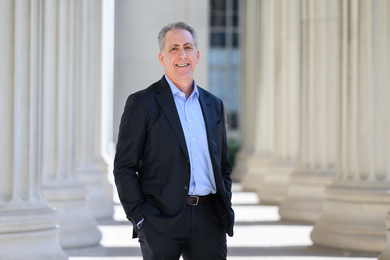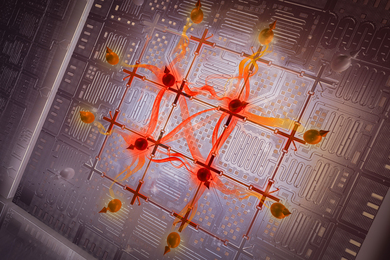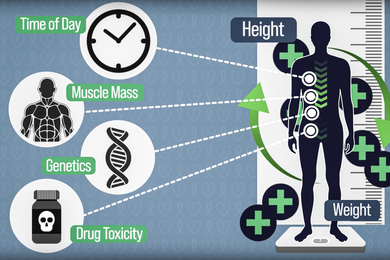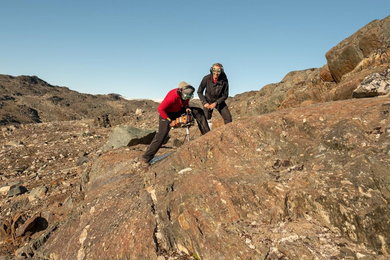Dr. Paul E. Gray, a national leader in education who has served MIT for 26 years as chancellor, then president and now chairman of the MIT Corporation, announced Friday that he would complete his service as chairman a year from now but continue to teach at MIT, his professional home since he entered as a freshman in 1950.
Dr. Gray, 64, told the members of the MIT Corporation on Friday, "I plan to continue as professor of electrical engineering for at least a few more years, teaching and advising undergraduate students, which is what I was doing before I became an officer of the Institute in 1971," Dr. Gray said. "Meanwhile, Priscilla and I are enthusiastic about the new opportunities that will open up once my schedule becomes a bit less demanding."
Dr. Gray began his remarks by saying, "For the past several months, I have discussed with the president and with the Executive Committee my desire to resign as chair of the Corporation a year from now, in June 1997. At that time I will have served as an officer of the Institute-in three different capacities-and as an ex officio member of the Corporation for 26 years."
President Charles M. Vest said, "I have been extremely fortunate to have the advice, counsel and personal friendship of Paul Gray. His experience, wisdom and good common sense have served MIT exceedingly well for decades, and certainly have been a great help to me. I can think of no one more deeply and effectively devoted to MIT. Happily, our students will continue to benefit from his teaching, and we will continue to rely on his good judgment."
Dr. Gray, who received bachelor's, master's and doctor of science degrees from MIT in 1954, 1955 and 1960, respectively, began his teaching career as an instructor at MIT in 1957. He served as chancellor from 1971-1980 during the presidency of the late Jerome B. Wiesner, as president from 1980 to 1990, and as chairman since then. He returned to teaching undergraduates in 1991, and has taught three sections of 6.002 (Circuits and Electronics) the first professional course in electrical engineering, and three freshman seminars, "What can Japan and America learn from each other?"
An interviewer noted to Dr. Gray that he was probably the only chairman of the board of a $1.2 billion organization who is ending his service as chairman to take up teaching and advising undergraduates. "Well, that's probably right," Dr. Gray said with a grin. Why do you continue to teach? he was asked.
Dr. Gray replied, "In 39 years around here as an employee, I have done a lot of things-eaching assistant, instructor, assistant professor, associate provost, dean of engineering, chancellor, president, chairman. Of all those, the ones that have given me the most satisfaction are teaching, and advising. I would not want to be a classroom teacher and not have any advising.
"As a teacher and adviser, you are in contact with this extraordinary set of young people, so able and committed, and you have this grand chance to see them grow. They come in as late adolescents and they leave four years later as professionally competent, mature young men and women. That's what makes it so satisfying."
Concerning the Corporation, Dr. Gray said, "If the legislature in 1861 had called it the Board of Trustees, there would be a lot less confusion. The act of the legislature that brought MIT into existence defined the Corporation and gave it the power of governance. The 70 individuals and eight ex officio members have the ultimate legal and moral responsibility for what happens at MIT. These people collectively are accountable to the public for their actions, and that is an accountability that is enforced by the state attorney general."
Dr. Gray is a member of a number of professional societies. He currently serves as treasurer of the National Academy of Engineering, which elected him to membership in 1975.
Dr. Gray has seen huge changes in MIT since he entered as a freshman in 1950. Then, the student body was about 5,400, three-quarters of whom were undergraduates, almost all male; the faculty numbered about 450, and the endowment was $50 million.
Today, after Dr. Gray's years at MIT, including 16 years as president and chairman, the student body is a very diverse group of roughly 10,000 students, including 3,000 women and 2,600 US minorities. Undergraduates number 4,500 (of which 44 percent are US minorities and 38 percent are women) and graduate students total 5,500 (of which 12 percent are US minorities and 24 percent women). The endowment is more than $2.1 billion.
A search committee to find Dr. Gray's successor has been appointed. It is composed of four members of the Corporation's executive committee, and is expected to bring a recommendation to the 78-member Corporation in the next academic year.
At its initial meeting Thursday, the committee met with Howard W. Johnson, president emeritus and former chairman of the Corporation, Dr. Vest, and Lawrence S. Bacow, chair of the faculty, to discuss the search process.
The search committee will be headed by W. Gerald Austen '51, of Boston, surgeon-in-chief of Massachusetts General Hospital, and Edward D. Churchill, professor of surgery at Harvard Medical School. The other members are Edward E. David Jr. '47, of Bedminster, NJ, retired president of Exxon Research and Engineering Co. who served President Nixon as science advisor; Judy C. Lewent '72, of Whitehouse Station, NJ, senior vice president and chief financial officer of Merck & Co., Inc.; and Morris Tanenbaum of Short Hills, NJ, retired vice chairman of the board of AT&T. Walter L. Milne, retired assistant to the chairman and the president, who has staffed search committees for the presidency in 1980 and 1990, will be staff to the committee.
A version of this article appeared in MIT Tech Talk on June 12, 1996.





